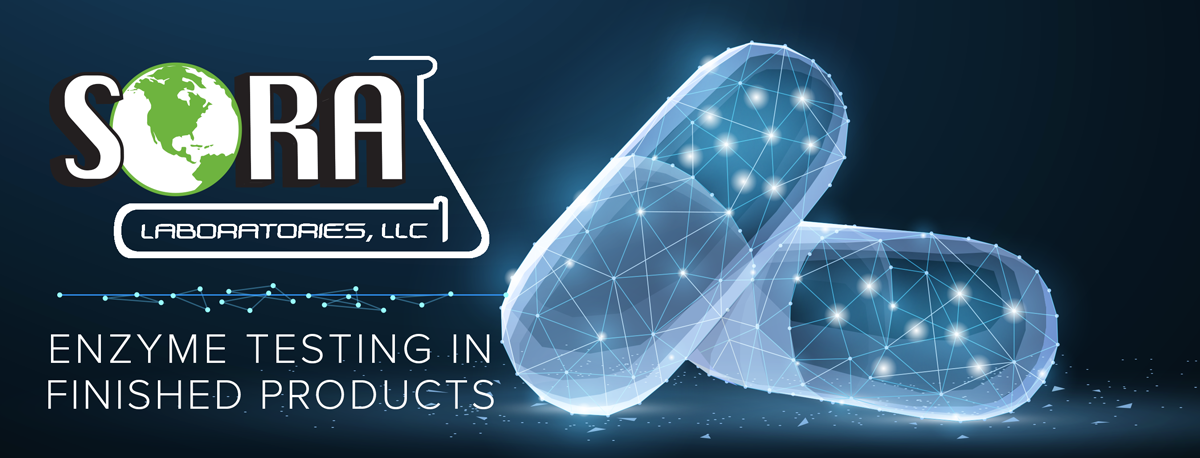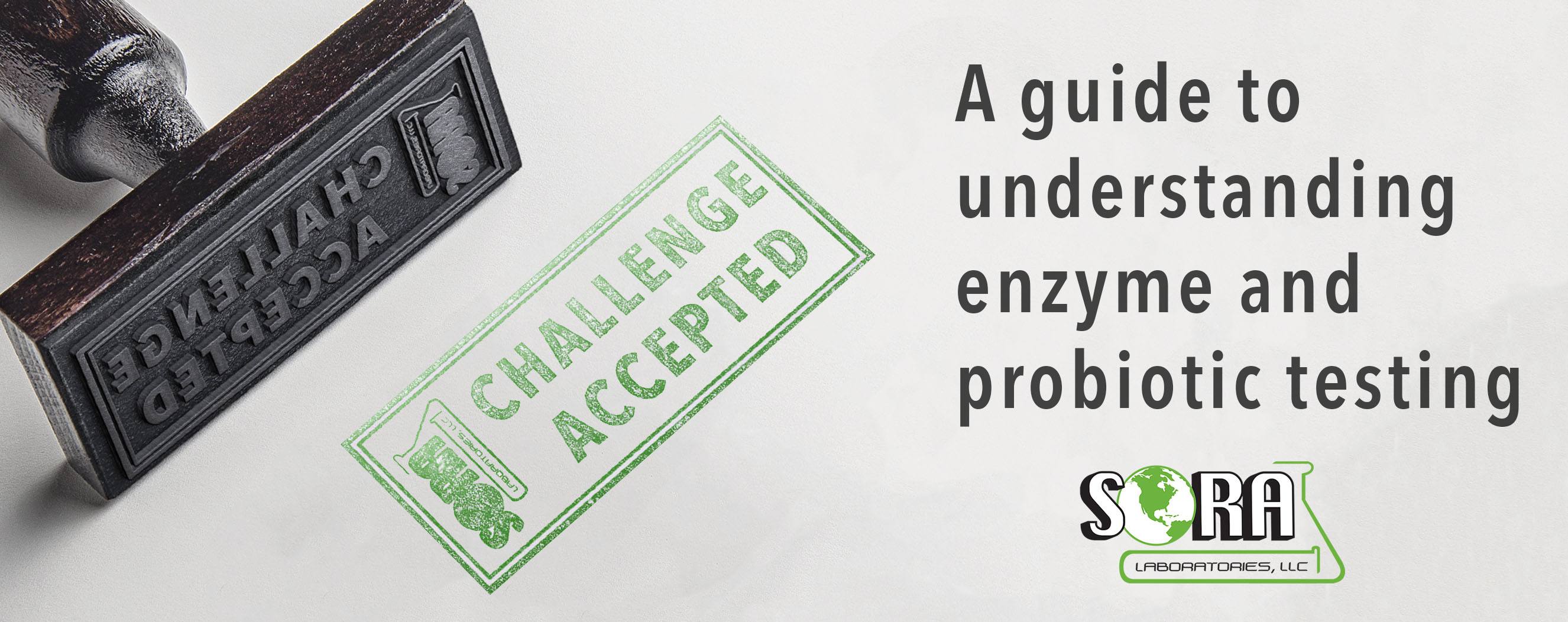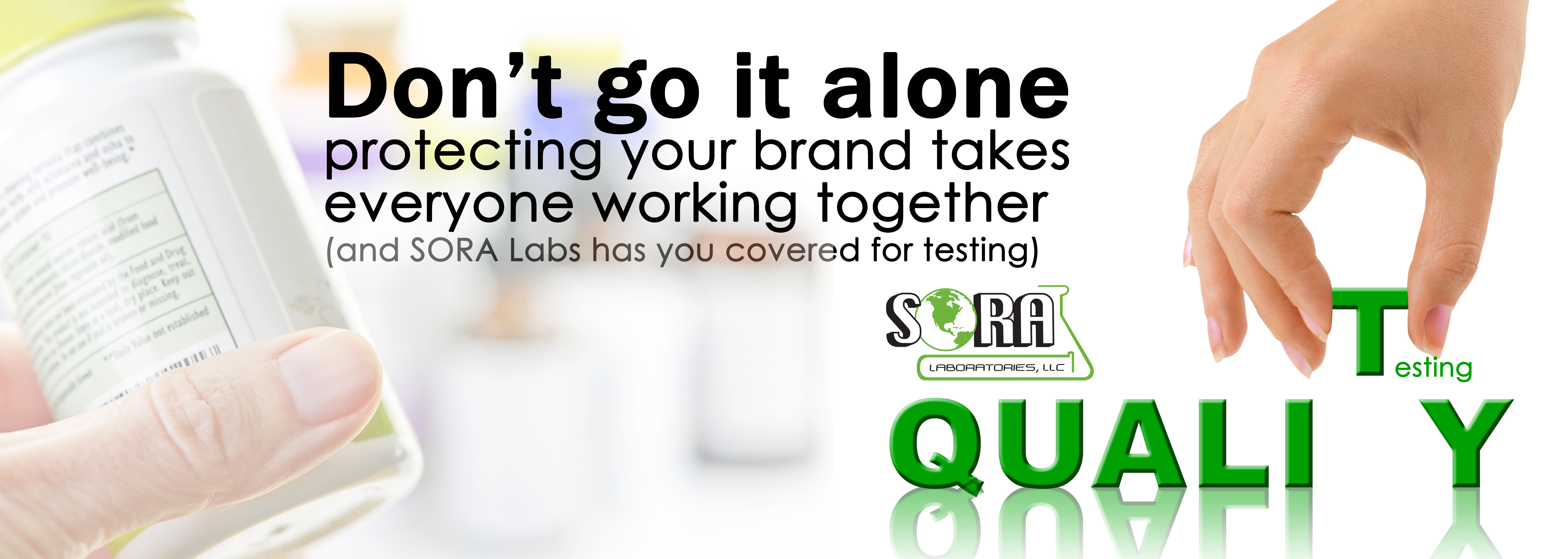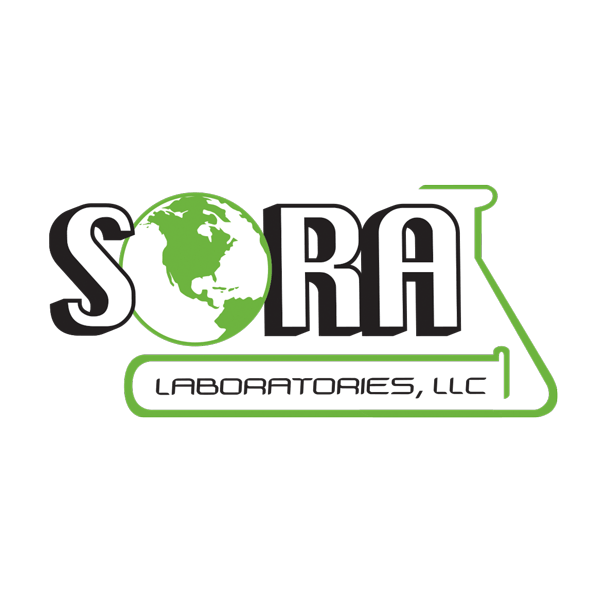SORA Labs has been testing enzyme activity assays and probiotic enumeration for more than 30 years. In fact, we were the first lab to add enzyme activity assays to an ISO/ICE 17025:2015 scope of accreditation in the U.S. Most of the methods we use come from the USP/FCC, BP, JP and other compendia, which are designed for raw material testing. One question we hear frequently is if it’s possible to test enzyme activities in finished products containing an enzyme blend. The answer is YES! We can test enzymes in finished products, however, like most analyses, it’s not as straight forward as raw material testing. Based on these experiences, we have put together a list of common interferences seen with finished product enzyme testing.
1) Combined Protease Effect: This occurs when several proteases are mixed together in a single blend. The protease activity of each enzyme is magnified by synergistic effects and boosts the protease activity. Enzymes are standardized to a single activity but may have other non-standardized activities present. These non-standardized activities are called side activities and can cause the proteases to show higher than expected results.
2)Enzyme/Carbohydrate Interference: The most common observation of this phenomena is with lactase but can be seen with other enzymes also. Lactase results often fall below label claims because of carbohydrates in the blend.
3) pH Co-Ingredient Interference: Enzyme activity assays are pH and temperature- controlled reactions. When the assay conditions are altered, the reaction may be affected, and the method may not perform correctly. Ingredients like betaine HCl, lemongrass, calcium carbonate, ox bile, and other high or low pH ingredients may swing the pH of the reaction solution outside the ideal method pH. Sometimes adjustments can be made to allow the reaction to run, but this is not always the case.
4) UV Co-Ingredient Interference: Many enzyme activity assays have a UV-Vis endpoint. If botanicals or other chemical ingredients are included in the enzyme matrix finished product, these ingredients may cause UV interferences. Methods that look for a change in UV absorbance could show inaccurate readings if these co-ingredients have similar UV characteristics.
Providing as much information about your product before testing begins will help determine possible interfering ingredients. When a testing lab is an extension of your team, you have a tremendous asset, because all these interference scenarios can be proven with testing.
We often use small sized, formulation-specific, lab blends, which allow us to remove the interfering ingredient(s) and then test the activity again. If the recovery is improved and the results meet label claims, then the product interference is confirmed.
We can also perform spike studies and measure the recovery of a known enzyme spike. Adding a known amount of enzyme into the finished blend and then testing for activity, will help determine the interference. When only partial recovery of the spike is observed, then this shows that there is interference with the testing.
Getting the blend testing and interferences figured out at the product development stage is very important to preventing product delays later in the process. Once products are ready to be shipped, then it is often a stressful scramble to understand why label claims are not being met. SORA Labs is here to help! Let us test your products so you can understand any interferences that are present. Remember, understanding your product’s unique characteristics early on, will help set the stage for successful manufacturing and sales.
Trusted testing services—the team approach
For ingredient suppliers, contract manufacturers and brand owners, partnership with a testing lab is often a necessary component. Even with an in-house lab, a company may not be able to perform every test required for their products due to the extensive nature of various testing practices and methods. When complicated, cost prohibitive, or specialty methods are required, partnership with an experienced testing lab, makes perfect sense—enter specialty 3rd party testing labs like SORA Labs.
The FDA Code of Federal Regulations requires that a vendor be qualified, and just like any other vendor, labs should be questioned about the expertise of methods they run. Reviewing proficiency testing; requesting staff qualification and reviewing standard operating procedures (SOP), can provide valuable insight when evaluating a lab. Ultimately, an on-site audit is the best strategy when making a final determination of a lab’s worthiness. Another qualifier when choosing a lab is the ISO 17025:2005 accreditation from the International Organization of Standardization. This signifies that the lab has met stringent criteria and passed audits to be considered a high quality international testing lab.
A lab partnership should also include a Quality Agreement (QA), which defines responsibilities, methods, out-of-specification communication and more. As regulations are increasing, the industry continues to see more findings regarding quality control procedures. An in-place agreement will ensure the quality process has been defined for outsourced testing, and both companies understand each other’s roles and expectations. If a Quality Agreement has not yet been established, you can find our QA form here (Quality Agreement Form Request). Since ISO already requires the highest level of confidentiality, a Non-Disclosure Agreement (NDA) is less important than the Quality Agreement; however some companies choose to have both agreements in place.
Although you may not need outside testing services on a daily basis, it’s a smart idea to have a qualified and experienced lab in your corner when the need arises. Sometimes, it can take a team to get your project completed and partnering with a high-quality testing lab like SORA Labs, is a great place to start. Let us help you today!
Challenge accepted . . . A guide to understanding enzyme and probiotic testing
Similarities between enzyme activity assays and probiotic enumeration are more common than most people realize. Both methods of testing require many dilutions, multiple calculations and are technique-driven. Our lab performs the probiotic colony forming unit (CFU) assays in our microbiology lab, and enzyme activities are tested in our chemistry lab. Both probiotics and enzymes aid in digestion and have potency that cannot be measured by weight or mg. Instead, probiotics are measured by CFUs and enzymes are measured in various activity units, with both having a variety of assay methods available. The ingredient supplier will often have a specific method for their product, and there may also be compendial methods listed in the Food Chemical Codex (FCC). While probiotic suppliers have not started standardizing to the compendial methods as of yet, enzyme ingredient suppliers use the FCC methods to standardize their products, for the most part. As time goes on, the probiotic industry may start standardizing to similar methods like the enzyme industry.
Both probiotic enumeration and enzyme activity assays listed in the FCC, are designed for raw material ingredients. Ideally, these assays should be performed on an ingredient before it is blended with other ingredients or encapsulated as a finished product. When multiple enzymes or probiotic strains are blended together, the testing becomes more difficult. There are common interferences with blended enzymes products, and also challenges with the multiple probiotic blends. Since each blend is unique and will interact in its own way, testing them can be tricky. However, it is possible to have successful results and gain valuable data about your product when tested correctly.
But, just as there are many similarities, there are also differences. Probiotic strains are living organisms, where enzymes are not. Instead, enzymes are ingredients, which break down food, whereas probiotics add to our gut flora for various health benefits. Lastly, enzyme activity is measured by substrate breakdown, instead of plate growth which measures probiotics.
Ultimately, both have complex test methods and require a high level of expertise and years of practice to perform accurately. SORA Labs is your trusted partner for both enzyme and probiotic With developed methods, we can help you learn more about your product through Testing is the only valid method to prove the quality of your product, so choosing an experienced lab is a must. Call us today for a quote!
You can’t go it alone—protecting your brand takes everyone working together!
The quality of the products under your brand is one of the most critical aspects of business success and vendor/supplier qualification is one of the most important steps in that process. In fact, this step is required in the Code of Federal Regulations (CFR) 111.75. Furthermore, to avoid warning letters, build confidence and maintain a positive reputation in the marketplace, safe and tested ingredients are a must.
CFR 111.75 outlines a very detailed process to follow. One of the first steps in establishing the reliability of the supplier’s certificate of analysis (CoA) is through confirmation of the supplier’s test results or examinations. This can be accomplished by setting the specifications and then testing using one or more methods for identity, purity, strength and composition of the component or ingredient. Also required by CFR 111.75 (c)(1), is testing for limits of contamination that would lead to adulteration of the finished product. This testing verifies that the vendor shows identity and acceptable levels of active ingredient markers. It also ensures that there is no microbial contamination, heavy metals, pesticide residue or other harmful contaminates.
Another key to supplier qualification is the supplier audit, which provides valuable information about the quality management system of the supplier. It also shows how the material is tested and how the vendor will ensure specification compliance from batch to batch, along with many other aspects of the company’s processes. By combining testing with supplier audits, a brand can consistently monitor the supplier and build confidence in its ability to produce high-quality ingredients. Once the supplier has been qualified, then reduced testing might be an option.
One FDA response letter (Addressed to Heron Botanicals Inc. on May 25, 2015) prompted the company to defend its position that it makes no claims to the amount of “active ingredients” in its finished product. As such, the company argued that testing was not needed for the “active ingredients” in the raw material. The FDA disagreed with this response because the company lists a 70 percent extract material on its label. Without testing the raw material, the company was unable to prove it started out with a 70 percent extract.
If this company had established a supplier qualification and showed testing results for the raw material over several lots to prove it met label claims repeatedly, then it may have been able to justify not testing the raw material “active ingredient” for this product. In this instance, the documented supplier qualification may have been all that was needed to avoid a warning letter.
Vendor qualification, although an often under-utilized process, is really the key to safe and high-quality ingredients. By testing raw materials and qualifying suppliers, this will strengthen the quality of your products and help protect your brand. Ultimately, It takes everyone working together to ensure the quality of the supply chain—and that definitely should be the main goal of any manufacturer. Are you doing your part to avoid FDA warning letters and produce quality products by working with a quality, certified and accredited testing lab? If not, SORA Labs can be your partner in quality!
Ingredient adulteration—what you need to know now!
By definition, adulteration means, “to make impure by adding extraneous, improper or inferior ingredients.” The FDA/USDA considers “adulteration a legal term if a food product fails to meet federal or state standards. This usually refers to noncompliance with health and safety standards as determined in the US, by the FDA and the USDA.”
In a recent FDA warning letter to TerraVare, Inc., dated 7/12/16, the FDA stated: “These violations cause your High Frequency Super Food Formula dietary supplement products to be adulterated under Section 402(g)(1) of the Federal Food, Drug, and Cosmetic Act (the Act) [21 U.S.C. §342(g)(1)] because they have been prepared, packed or held under conditions that do not meet the CGMP regulation for dietary supplements.”
Adulteration can happen in many forms. One example is adulteration with illegal or tainted substances. Other issues may include heavy metal contamination; high level microbiological counts; and residues like pesticides or solvents. Testing is the key to knowing exactly what is in your products, although not every adulterant can easily be found. However, if you are testing for known contamination and adulteration potentials, this is a great place to start finding any problems.
Case in point—in 2013, an enzyme recall occurred after chloramphenicol, an antibiotic drug residue, was found in digestive enzyme products. No one would have ever expected an adulterant or illegal substance in this type of product. As a result, many enzyme manufacturers now screen incoming raw materials for chloramphenicol, as it’s now considered an adulterant to watch for in these types of products. Subsequentially, testing for chloramphenicol residue in enzymes is now a normal quality check, performed routinely in our lab.
When choosing what testing is needed for your materials, you must evaluate the product for known contamination risks. Since botanical or herbal ingredients are grown outside, potentially coming in contact with pesticides for insect control, a pesticide residue screen would be able to verify that the botanical is clean and free from any pesticide residue. For botanicals labeled organic, this is even more critical, as unintended contamination from pesticide runoff in other fields could have occurred. The pesticide residue must be monitored to ensure that the material would not be considered adulterated
Plant material and anything grown in the soil, is also susceptible to higher heavy metal and microbiological counts in countries with crude waste disposal or poor water quality. Botanical ingredients must be tested to ensure that they are safe for human consumption. Also, since microbiologic counts could be high in botanical materials, processors may use irradiation treatments to help lower the bacterial counts. In many countries, including the US, materials that have been irradiated must be labeled as such. USP <2250> Pulsed Photo Simulated Luminescence (PPSL) was added to the USP in 2015 as a testing method to detect irradiation of ingredients. Testing to determine if your material has been irradiated will allow you to label your finished product correctly.
Adulteration of products is serious business, as many high-profile supplements have been abruptly yanked off the shelves by the FDA because they included illegal ingredients. It is imperative to make sure your product matches your label claims and is free of any unintended ingredients. Your quality team will be tasked with deciding what testing is needed for each material that will be used in manufacturing, and knowing who to call for your testing needs is paramount. Just know, SORA Labs is always here to help with testing any of your testing needs—let us be an extension of your quality team!
Probiotic testing challenges—the right lab makes all the difference!
Probiotic testing can be complicated. Here’s why—most of the testing methods available are for single strain raw materials. Additionally, many methods come from the manufacturer and are specific to their material. And if that didn’t create enough confusion about what testing was appropriate, the Food Chemical Codex (FCC) has also added several probiotic monographs. These monographs have procedures for identification, enumeration assays and specific Whew! So how can you decide which testing method to use—the answer lies within using a lab that is experienced in probiotics.
An experienced lab like SORA, will know that the identification portion of the FCC monograph is for nucleic acid-based identification using PCR or other genetic identification methods. The assay portion of the monograph uses various growth media and specific aerobic or anaerobic conditions for optimal growth of the probiotic strain. The specific test section will have testing recommendations for that particular strain of probiotic.
Since these procedures require specialized equipment, and specific agars and broths to perform the testing, this can be challenging due to the high growth counts of this material. Typically in a microbiology lab, the samples being tested have very low plate counts, but with probiotic material, high counts in the millions or even billions of cfu/g are expected. Lab contamination is also a concern when working with probiotics, so proper sample handling is very important to ensure that the testing environment and air quality stays clean. Because of these challenges, working with probiotics in a separate section of the lab and at separate plating times is often required to avoid microbiology contamination of other samples in the testing lab.
While finding the best assay method may be difficult when working with blended probiotic strain products, reviewing the individual strain methods and looking for overlapping testing is generally a good starting point. And, since there may not be one “ideal” method, the testing lab may need to attempt several probiotic methods and perform method development before exact testing can be determined for the specific product.
With so many challenges, it may seem daunting to make sure your product is being properly tested! However, choosing a lab that is accustomed to handling probiotic material and performing specialized testing such as SORA Labs, can take the stress out of making sure your product meets label claims—choose wisely.
Need an extra hand…or two?
Ever felt like you could use an extra hand or just needed an extra team member who could provide specialty services that you desperately need from time to time? SORA Labs wants to be a valuable extension of your quality control department. How can we do this for your team? By providing fast, reliable testing services that are available when you need them.
The FDA CFR 111 requires that a manufacturer establish product specifications for identity, purity, strength and composition for the limits of those types of contamination that may adulterate or that may lead to adulteration of the finished batch of the dietary supplement. To prove that the material is within specification, testing must be conducted.
Identity testing is the first step in verifying that you have the correct ingredient in your product.
Using compendia like the USP, FCC, BP or organizations that provide validated methods like the AOAC or ACS is a great place to start when determining your testing needs. Also, using reference standards to verify ingredient identity is also invaluable. The USP, for example, offers many testing recommendations such as:
- Gelatin testing- ID-A and ID-B are listed for standard gelatin and ID-C is listed for non-gelling ID. The USP lists specific tests and contamination testing recommendations for microbial and heavy metals.
- Ginkgo Extract- TLC ID and HPLC retention time peaks are listed for identification. Composition testing is for the active marker assays including Flavonol Glycosides and Terpene Lactones. The contaminate testing includes pesticides, residual solvents and microbial limits
- Wheat Bran- Microscopy is listed as the ID. Composition testing includes the amount of total dietary fiber and contaminate testing shows insect infestation and microbial limits.
- Biotin shows ID-A as FTIR; ID-B is Optical Rotation; and ID-C is HPLC retention time peaks. The assay uses HPLC and measures the active marker of Biotin.
- Papain is determined by a wet chemistry enzyme activity reaction with a UV-Vis end-point. There are some specific tests listed and the USP reference standard is noted.
Based on the wide variety of testing recommendations for just these few ingredients, it’s easy to understand the amount of equipment and expertise it takes to effectively test these products. Since setting up an analytical and microbiology testing lab requires a large capital investment and, for some companies, may be cost prohibitive, this is an excellent reason to use a quality third-party lab, such as SORA Labs. This gives us the opportunity to be that extra bit of help when you need it the most.
Another reason to use a qualified and accredited testing lab is to help avoid FDA warning letters like this recent one addressed to Pacific Nutritional. On April 15, 2016, the FDA wrote “Once you have established finished product specifications, you must verify that the specifications are met, as required by 21 CFR 111.75(c), and you must also ensure that the tests and examinations that you use to determine whether the specifications are met are appropriate, scientifically valid methods, as required by 21 CFR 111.75(h)(1). In addition, you must make and keep records in accordance with 21 CFR 111.95(b).”
From testing the initial raw material to the completed finished goods, SORA is here to help. As an ISO 9001:2008 certified and ISO 17025:2005 accredited testing lab, let us be a valuable part of your quality team!






